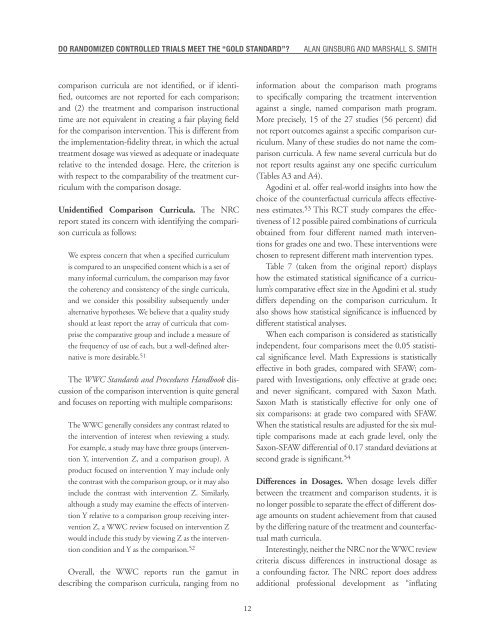Do Randomized Controlled Trials Meet the “Gold Standard”?
Do-randomized-controlled-trials-meet-the-gold-standard
Do-randomized-controlled-trials-meet-the-gold-standard
Create successful ePaper yourself
Turn your PDF publications into a flip-book with our unique Google optimized e-Paper software.
DO RANDOMIZED CONTROLLED TRIALS MEET THE “GOLD STANDARD”?<br />
ALAN GINSBURG AND MARSHALL S. SMITH<br />
comparison curricula are not identified, or if identified,<br />
outcomes are not reported for each comparison;<br />
and (2) <strong>the</strong> treatment and comparison instructional<br />
time are not equivalent in creating a fair playing field<br />
for <strong>the</strong> comparison intervention. This is different from<br />
<strong>the</strong> implementation-fidelity threat, in which <strong>the</strong> actual<br />
treatment dosage was viewed as adequate or inadequate<br />
relative to <strong>the</strong> intended dosage. Here, <strong>the</strong> criterion is<br />
with respect to <strong>the</strong> comparability of <strong>the</strong> treatment curriculum<br />
with <strong>the</strong> comparison dosage.<br />
Unidentified Comparison Curricula. The NRC<br />
report stated its concern with identifying <strong>the</strong> comparison<br />
curricula as follows:<br />
We express concern that when a specified curriculum<br />
is compared to an unspecified content which is a set of<br />
many informal curriculum, <strong>the</strong> comparison may favor<br />
<strong>the</strong> coherency and consistency of <strong>the</strong> single curricula,<br />
and we consider this possibility subsequently under<br />
alternative hypo<strong>the</strong>ses. We believe that a quality study<br />
should at least report <strong>the</strong> array of curricula that comprise<br />
<strong>the</strong> comparative group and include a measure of<br />
<strong>the</strong> frequency of use of each, but a well-defined alternative<br />
is more desirable. 51<br />
The WWC Standards and Procedures Handbook discussion<br />
of <strong>the</strong> comparison intervention is quite general<br />
and focuses on reporting with multiple comparisons:<br />
The WWC generally considers any contrast related to<br />
<strong>the</strong> intervention of interest when reviewing a study.<br />
For example, a study may have three groups (intervention<br />
Y, intervention Z, and a comparison group). A<br />
product focused on intervention Y may include only<br />
<strong>the</strong> contrast with <strong>the</strong> comparison group, or it may also<br />
include <strong>the</strong> contrast with intervention Z. Similarly,<br />
although a study may examine <strong>the</strong> effects of intervention<br />
Y relative to a comparison group receiving intervention<br />
Z, a WWC review focused on intervention Z<br />
would include this study by viewing Z as <strong>the</strong> intervention<br />
condition and Y as <strong>the</strong> comparison. 52<br />
Overall, <strong>the</strong> WWC reports run <strong>the</strong> gamut in<br />
describing <strong>the</strong> comparison curricula, ranging from no<br />
information about <strong>the</strong> comparison math programs<br />
to specifically comparing <strong>the</strong> treatment intervention<br />
against a single, named comparison math program.<br />
More precisely, 15 of <strong>the</strong> 27 studies (56 percent) did<br />
not report outcomes against a specific comparison curriculum.<br />
Many of <strong>the</strong>se studies do not name <strong>the</strong> comparison<br />
curricula. A few name several curricula but do<br />
not report results against any one specific curriculum<br />
(Tables A3 and A4).<br />
Agodini et al. offer real-world insights into how <strong>the</strong><br />
choice of <strong>the</strong> counterfactual curricula affects effectiveness<br />
estimates. 53 This RCT study compares <strong>the</strong> effectiveness<br />
of 12 possible paired combinations of curricula<br />
obtained from four different named math interventions<br />
for grades one and two. These interventions were<br />
chosen to represent different math intervention types.<br />
Table 7 (taken from <strong>the</strong> original report) displays<br />
how <strong>the</strong> estimated statistical significance of a curriculum’s<br />
comparative effect size in <strong>the</strong> Agodini et al. study<br />
differs depending on <strong>the</strong> comparison curriculum. It<br />
also shows how statistical significance is influenced by<br />
different statistical analyses.<br />
When each comparison is considered as statistically<br />
independent, four comparisons meet <strong>the</strong> 0.05 statistical<br />
significance level. Math Expressions is statistically<br />
effective in both grades, compared with SFAW; compared<br />
with Investigations, only effective at grade one;<br />
and never significant, compared with Saxon Math.<br />
Saxon Math is statistically effective for only one of<br />
six comparisons: at grade two compared with SFAW.<br />
When <strong>the</strong> statistical results are adjusted for <strong>the</strong> six multiple<br />
comparisons made at each grade level, only <strong>the</strong><br />
Saxon-SFAW differential of 0.17 standard deviations at<br />
second grade is significant. 54<br />
Differences in <strong>Do</strong>sages. When dosage levels differ<br />
between <strong>the</strong> treatment and comparison students, it is<br />
no longer possible to separate <strong>the</strong> effect of different dosage<br />
amounts on student achievement from that caused<br />
by <strong>the</strong> differing nature of <strong>the</strong> treatment and counterfactual<br />
math curricula.<br />
Interestingly, nei<strong>the</strong>r <strong>the</strong> NRC nor <strong>the</strong> WWC review<br />
criteria discuss differences in instructional dosage as<br />
a confounding factor. The NRC report does address<br />
additional professional development as “inflating<br />
12



